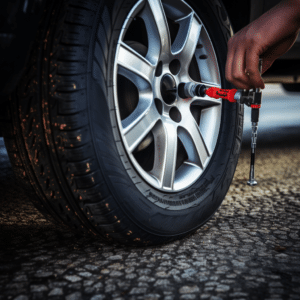
Mastering Tire Plugging: Temporary Fixes and Permanent Solutions
A plug is one of the quickest solutions to a tire puncture. You need less than 60 seconds for plugging. The technique prevents the tire from deflating fully. A tire plug is not a permanent fix. In addition, you should not drive your vehicle for so long after fixing the tire plug. They only serve as a temporary solution.
Consider visiting the repair shops and asking experienced mechanics how to fix the punctured tire permanently. There are situations that you might use the tire plug for several years, depending on the location and the extent of the tire damage.
For most people, a tire plug is a real savior. If you know how to fix it, it will get you out of problems. Tire plugs are easy to install, and they work as expected but not permanently. Notably, they are not meant to solve all the tire problems. Here are some of the details that you need to know before installing a tire plug.
What Is A Tire Plug?

Tire plugs were introduced back in early 1800 when long-distance travelers used things like metal wires or tree roots for emergency puncture repairs. Over time, the tire plugging technique has evolved, and now there is no more guesswork. If you want to solve the puncture problems using a plug, you need first to identify the puncture hole from the outside.
When doing tire plugging in whichever place on earth, you won’t lack items to help you do the technique in style. Of course, you have a toolbox full of various handy things. That is the one that will salvage you from all the puncture-associated problems.
It has been debated widely whether the tire plug should be permanent or temporary. The experts have concluded, and it’s now clear that it’s a temporary fix. They are only used to block the hole and prevent too much air from escaping. Again, it’s not something that will hold up effectively to the constant wear and tear experienced after thousands of miles.
It’s not worth the risk if you opt to use the standalone tire plug as the permanent solution. If anything happens that makes the plug jump out, the next thing is a tire blowout. Tire blow at high speed on the highways leads to a deadly accident. That is easy and cheaper to prevent.
Therefore, because of too many risks associated with tire plugging. After using the same temporary solution, let the mechanics do proper patching. A permanent seal should be installed around the damaged area. If you want to be in safer hands while driving, please consider tire plugs as a short-term solution and not a long-term fix.
Can You Do Tire Plugging Twice?
It’s never a smart idea to plug your tire twice. According to specialists, tires should only be plugged once, after which you should consider replacing the tire. You’ll avoid a blowout by replacing a clogged tire, and you’ll be able to travel safely on your wheels.
When Not To Use a Tire Plug
In some cases, tire plugs will not be effective. Using a plug can sometimes be more harmful than beneficial. In such cases, it is preferable to delegate the leak to an expert. From there, the necessary fixation will be sought out. Here are some scenarios in which you may require more than simply a plug:
Multiple Holes
Although several holes in a tire can be repaired by patching or plugging, it’s not recommended if they are within a circumference of 16 inches from each other. You will need to change your tires in this situation. Also, don’t attempt to repair large holes in your tire because your efforts may be ineffective or cause more harm than good. Visit the car service centers.
Tire Wall Holes
If the hole in your tire is on the walls, never fill or repair it with a tire plug. The plug repair techniques are only safe to use on the treads. Using them on the walls will only put you in danger.
Diameter of 14 Inches or More
Please make sure the hole in your tire is smaller than 14 inches in diameter before plugging it. It’s not a good idea to fill a hole larger than that.
Plugs versus Patches
If you are to decide between a plug and a patch, here’s the deal: both are effective depending on the damage!
Patches are frequently the favored form of tire repair since experts and beginners may do them. You’ll have to spend a lot of money to fix a patch.
The tire professionals will remove your tire from your vehicle, examine it for leaks, and then repair it from the inside out to guarantee a secured patch. Your tire professional will leave nothing to chance, thanks to the sophisticated process.
On the other hand, tire plugs are significantly easier to replace and may be done by anybody. When compared to tire patches, they will cost you a little less. They also require less time because the tire does not have to be removed from the vehicle to install the plug.
If you are certain that you will replace your tire, a plug is the best option. If you want something a little more permanent, patches are the way to go.
When Should You Replace a Plugged Tire?

It would be important if you consider replacing your plugged tire as soon as possible, regardless of how good it looks or feels. However, you can drive around with plugged tires for a month or so, but not longer than that.
Alternatively, you might speak with a tire expert to give their take on the status and condition of the tires. Replacing a newly purchased tire may be a frustrating experience. When you evaluate the safety benefits that come with a new tire, it becomes much more bearable.
The best part about tire replacement is that you don’t have to buy new ones. You might replace your automobile tires with slightly used ones that would serve the same purpose.
As you can see, there are several dos and don’ts when it comes to tire plugging. The major don’t, is to use tire plugs as a permanent solution. Remember that the next time a nail gets stuck in your tire, a tire plug only serves as a temporary solution.
